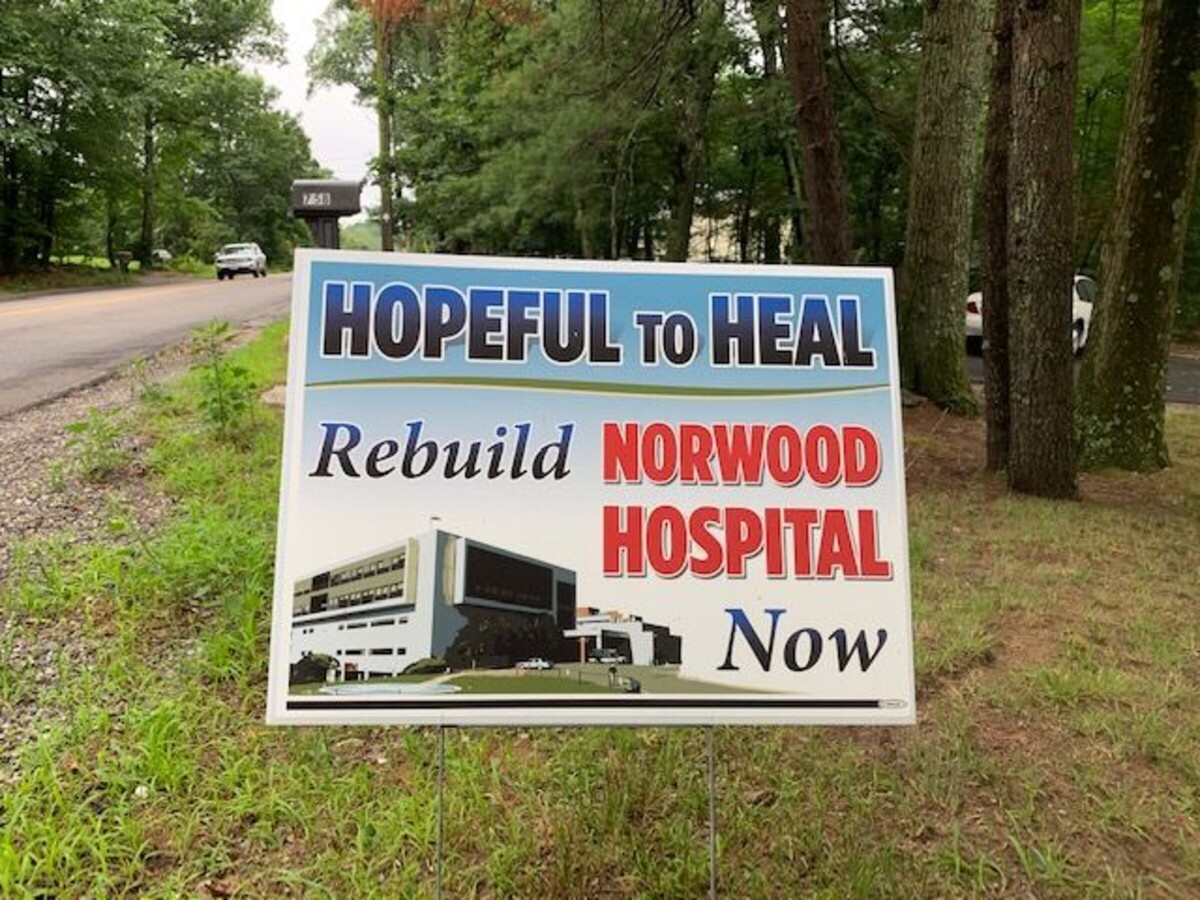Image

Signs were popping up around town over the summer: signs of hope. They asked for something simple: Norwood Hospital.
An institution in the region for generations, and a place many in Franklin chose for their medical care, the hospital’s future was put into question in matter of minutes last year, when a sudden, unexpected flash flood overwhelmed the hospital’s functions, severely damaging structure and equipment alike.
June 28, 2020 brought an unprecedented four inches of rain to Norwood in just a few hours, something designers had never anticipated. And with the hospital located in a flat and low-lying area, when water began to quickly rise, there was no place for it to go.
Patients had to be evacuated and medical care ceased. And much of the buildings equipment and supplies were not salvageable.
Fortunately, the region has other hospitals, and despite the additional strains imposed on the medical system by Covid, the consequences were not severe.
But there were consequences. Most notably, people in or near Norwood now had to go much farther for testing, emergency services, delivering a baby, or surgery. According to a Fox 25 report, emergency responders from Norwood itself made more than 2,300 trips to hospitals in Boston, Brockton, Needham and Newton, according to a list of ambulance runs between June 2020 and June 2021
And Franklin wasn’t immune since a significant number of residents had ties to the hospital.
According to Fire Chief James McLaughlin, the impact on the town’s emergency services has been minimal since most calls go to Milford Hospital, unless an individual or family expresses a preference for Norwood Hospital. But where all of the town’s ambulances now go to Milford as do most of those in towns like Norfolk or Wrentham, the impact on Milford Hospital has been more significant.
According to a spokesperson for Milford Hospital, emergency and elective procedures are up significantly there since Norwood close, in many cases serving people from the traditional service area of Norwood Hospital.
And, for those with ties to Norwood, and for those who lost jobs when the facility closed, waiting has been painful.
Finally, just about a year after the flood, and after 100 people rallied in Norwood to demand the hospital be reopened, Norwood Hospital provided a glimmer of hope, a statement indicating that rebuilding was being planned. But details were slim.
The Challenges of Rebuilding Norwood Hospital
It was something that thousands of people in the region had been awaiting, an announcement from Norwood Hospital President Salvatore Perla. It came on June 22. He promised there would soon be an “official announcement” but said that a decision had been made to rebuild in the same location.
As of this writing, more concrete information has not been forthcoming.
Might there be problems at Steward Health Care, the parent, for-profit company that owns the facility?
In 2019, before the pandemic, Steward ranked as one of the largest U.S. chains of for-profit hospitals, with $6.6 billion in annual revenue in 2018. Yet, the organization, which grew rapidly through acquisition, was described by one writer as being “on a financial knife’s-edge.” For example, to finance growth, Steward reportedly sold off the real estate occupied by some of its own hospitals, calling into question its capacity to fund what is essentially a brand new hospital needed in Norwood.
Red Tape
Although the Massachusetts Department of Public Health declined repeated requests in July and August to provide comment on the challenges of opening or reopening a hospital, the agency’s web site provides some sense of the difficulties. For example, to achieve initial licensure, which would likely be the step needed for a hospital that has existed in name only for more than a year, applicants must go through the Determination of Need (DON) process and a Plan review
“Applicants must also submit appropriate programmatic documentation specific to their provider type,” and contact the appropriate licensure coordinator for the pages and pages of forms and documents required, the site states.
The Determination of Need (DoN) law and regulation governs Health Care Facilities apply when there is a Substantial Capital Expenditure, Substantial Change in Services and Original Licensure as well as many Transfers of Ownership and Changes in Site for Health Care Facilities must be reviewed and approved under the DoN Regulatory scheme.
According to the agency, the purpose and objective of the DoN program is to encourage competition with a public health focus; to promote population health; to support the development of innovative health delivery methods and population health strategies within the health care delivery system; and to ensure that resources will be made reasonably and equitably available to every person within the Commonwealth at the lowest reasonable aggregate cost.
So, Norwood Hospital must jump through a series of hoops, spending money and using time simply to get to the point where the organization would be allowed to rebuild.
But what if Steward (emailed and called multiple times, with no response) applies a purely business analysis to the decision? The company already has existing facilities in Canton and Brockton. While to the north, east, and west, the Partners Healthcare colossus looms. Perhaps they will question the value of investing so close to that powerful force.
What’s more, the existing Steward facilities still offer a lower cost option for area residents put off by the typically higher cost of Partners.
What will Steward do? For a year they have been mostly tight-lipped and certainly in no hurry to talk to a small community publication like the Franklin Observer at the edge of its service area.
Let us simply suggest that rebuilding may not be a certainty, though we hope we are proven wrong.